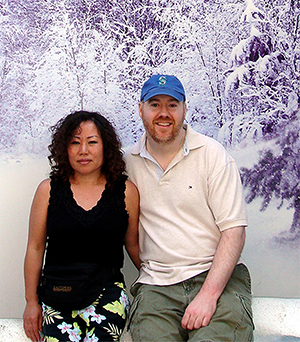

Spotlight on Life's Milestones
Life’s defining moments shape who we are and the paths we take. In this series, William and Hui Cha Stanek invite you to reflect on pivotal milestones, celebrating the journey and the lessons learned along the way.

Transform your life with practical wisdom. Discover William Stanek's 'Living Well' series—your guide to a balanced and fulfilling life.
Discover William Stanek's Exclusive Art Collection
Explore and purchase the stunning art featured on this site. Own a piece of William Stanek's unique and captivating artwork today!
(May 8, 2025) The Milestone of Solitude: Finding Peace in Being Alone
In a world that often equates solitude with loneliness, finding peace and fulfillment in being alone is a significant milestone in personal growth. Solitude, when embraced, becomes a powerful tool for self-discovery, creativity, and deep introspection. It offers us the space to connect with our inner selves, to reflect on our lives, and to discover insights that might remain hidden in the noise of daily life. In this article, we’ll explore the milestone of finding peace in solitude, how spending time alone can lead to profound self-discovery and creativity, and how these moments of quiet have influenced my life and work.
The Power of Solitude: Embracing Time Alone
Solitude is often misunderstood in our fast-paced, connected world. Many people associate being alone with loneliness or isolation, but solitude is something entirely different. It’s a deliberate choice to spend time with oneself, to turn inward, and to engage in deep reflection. Solitude is not about escaping from the world; it’s about creating space to reconnect with yourself, to explore your thoughts and emotions, and to find clarity in the quiet.
For me, solitude has been an essential part of my life and creative process. Early in my career, I discovered that some of my most profound insights and ideas came to me during moments of solitude. Whether I was walking alone in nature, sitting quietly in a room, or simply taking time to reflect at the end of the day, these moments of solitude provided a sanctuary where I could tune out the distractions of the world and listen to my inner voice.
One of the most significant realizations I had during these solitary moments was the importance of being comfortable with oneself. In solitude, there is no one else to rely on for validation or support—just you, your thoughts, and your emotions. This can be intimidating at first, especially if you’re not used to spending time alone. But over time, I learned to embrace these moments of solitude as opportunities for growth and self-discovery. I found that the more I engaged with my thoughts and emotions in solitude, the more I understood myself and the more confident I became in my own decisions and direction.
Solitude also played a crucial role in helping me navigate challenging periods in my life. During times of stress, uncertainty, or emotional upheaval, I often turned to solitude as a way to regain my sense of balance and clarity. By stepping away from the noise and distractions of the outside world, I was able to process my thoughts and emotions more effectively, to see things from a new perspective, and to find the strength and resilience to move forward.
The Role of Solitude in Creativity: A Space for Inspiration and Reflection
Creativity thrives in solitude. It’s in those quiet moments alone that we often find the inspiration and insight needed to create something truly meaningful. Solitude provides the mental space to explore ideas, to experiment without fear of judgment, and to reflect deeply on our work. It allows us to connect with our inner creativity, to listen to the whispers of our imagination, and to bring our visions to life.
Throughout my creative career, I have found that solitude is essential for fostering creativity. When I’m alone, free from distractions and external pressures, my mind has the freedom to wander, to explore new ideas, and to make connections that might not be immediately apparent. It’s in these moments of solitude that I’ve often experienced creative breakthroughs—those “aha” moments when an idea suddenly clicks into place, or when a solution to a problem reveals itself.
One of the most profound creative experiences I’ve had in solitude occurred during a period when I was struggling with a writing project. I had been working on the project for weeks, but something just wasn’t clicking. The more I tried to force the words to come, the more frustrated I became. Finally, I decided to take a step back and spend some time alone, away from the project. I went for a long walk in the woods, allowing my mind to wander freely.
As I walked, I began to let go of the need to find the perfect solution and simply allowed myself to be present in the moment. It was during this walk that the breakthrough came—a sudden flash of insight that transformed the entire project. The solution had been there all along, but it took a moment of solitude for me to see it clearly. This experience reinforced for me the idea that solitude is not just a place of quiet; it’s a place of inspiration, where creativity can flourish in the absence of distraction.
Hui Cha has also found that solitude plays a vital role in her artistic process. As an artist, she often spends hours alone in her studio, experimenting with new techniques, reflecting on her work, and allowing her creative instincts to guide her. These solitary moments are when she feels most connected to her art, free to explore and create without the influence of outside opinions. Solitude allows her to dive deep into her creative process, to explore new ideas and perspectives, and to create work that is truly authentic and reflective of her inner vision.
The Journey of Self-Discovery: Finding Clarity in Solitude
Solitude is not just a tool for creativity; it’s also a powerful means of self-discovery. When we spend time alone, we have the opportunity to reflect on our lives, our choices, and our values. It’s in these quiet moments that we can ask ourselves the big questions: Who am I? What do I truly want? What is my purpose? Solitude allows us to explore these questions without distraction, to listen to our inner voice, and to discover the answers that resonate most deeply with us.
One of the most significant periods of self-discovery in my life occurred during a time when I was grappling with a major life decision. I had reached a crossroads in my career, and I wasn’t sure which path to take. The decision felt overwhelming, and I found myself constantly seeking advice from others, hoping that someone else could provide the clarity I needed. But the more I sought outside input, the more confused I became.
Finally, I decided to spend some time alone, away from the opinions and advice of others. I took a weekend retreat to a quiet cabin in the woods, bringing only a journal and a few books for company. During this time of solitude, I allowed myself to reflect deeply on my life, my goals, and my values. I wrote in my journal, meditated, and spent hours simply walking in nature, listening to my thoughts and emotions.
It was during this time of solitude that the clarity I had been seeking finally emerged. I realized that the answers I had been looking for were within me all along—I just needed the space and quiet to hear them. This experience taught me the importance of trusting my own instincts and the power of solitude in helping me connect with my true self. It was a milestone in my journey of self-discovery, one that has continued to guide me in my life and work.
Hui Cha has also found that solitude is essential for her own journey of self-discovery. As an artist, she often uses moments of solitude to reflect on her work and her life, to explore new ideas and possibilities, and to connect with her inner self. These moments of quiet introspection allow her to discover new facets of her creativity, to understand her motivations and desires, and to align her work with her deeper sense of purpose.
The Challenge of Embracing Solitude: Overcoming the Fear of Being Alone
While solitude offers many benefits, it can also be challenging to embrace. In a world that often values constant activity and social connection, choosing to spend time alone can feel uncomfortable or even frightening. Many people associate solitude with loneliness, fearing that time spent alone will lead to feelings of isolation or inadequacy. But solitude is not about being lonely; it’s about being alone with yourself in a way that is fulfilling and enriching.
One of the challenges I faced in embracing solitude was overcoming the fear of being alone with my thoughts. Like many people, I was accustomed to filling my time with activities and distractions—work, socializing, entertainment—that kept me from facing the deeper questions and emotions within me. The idea of sitting alone with my thoughts, without any distractions, was intimidating. But I knew that if I wanted to grow and find peace within myself, I needed to confront this fear and embrace solitude as a necessary part of my journey.
Over time, I learned to see solitude not as something to be feared but as a gift—an opportunity to reconnect with myself, to explore my inner world, and to find clarity and peace. I discovered that the more I embraced solitude, the more comfortable I became with my own company, and the more I came to value the insights and creativity that solitude brought into my life.
Hui Cha also faced challenges in embracing solitude, particularly as an artist. The creative process can be isolating, and there were times when she struggled with the loneliness that often accompanies long hours spent alone in the studio. But she also recognized that solitude was essential for her work, providing the space and focus needed to create something truly meaningful. By embracing solitude as a necessary part of her creative process, she was able to find fulfillment in the quiet moments, using them as a source of inspiration and self-discovery.
Embracing Solitude: Steps to Finding Peace and Fulfillment in Being Alone
Finding peace and fulfillment in solitude is a journey, one that requires patience, courage, and a willingness to explore your inner world. By embracing the milestone of solitude, you can discover new insights, enhance your creativity, and deepen your connection with yourself.
Here are a few steps you can take to embrace solitude and find peace in being alone:
-
Start Small: If you’re new to solitude, start with small moments of alone time. Set aside a few minutes each day to sit quietly, without distractions, and simply be with yourself. Gradually increase the amount of time you spend in solitude as you become more comfortable.
-
Create a Solitude Ritual: Establish a regular practice of solitude that feels meaningful to you. This could be a daily walk in nature, a quiet meditation session, or time spent journaling. Having a ritual helps to make solitude a consistent and fulfilling part of your life.
-
Embrace Your Thoughts and Emotions: Solitude is an opportunity to explore your inner world. Allow yourself to fully experience your thoughts and emotions, without judgment or distraction. Use this time to reflect, to ask yourself important questions, and to listen to your inner voice.
-
Use Solitude for Creative Exploration: Tap into the power of solitude as a space for creativity. Use your alone time to brainstorm ideas, experiment with new techniques, or work on a creative project. Solitude provides the mental space needed for inspiration and innovation.
-
Practice Self-Compassion: It’s natural to feel uncomfortable or lonely at times in solitude. Practice self-compassion by treating yourself with kindness and understanding. Remember that solitude is a journey, and it’s okay to feel a range of emotions along the way.
-
Find Balance: While solitude is valuable, it’s also important to balance it with social connection. Find a balance that works for you, allowing time for both solitude and meaningful interactions with others.
The Transformative Power of Solitude: Living with Clarity and Creativity
Solitude is a transformative milestone that offers profound opportunities for self-discovery, creativity, and personal growth. By embracing solitude, you can find peace in being alone, connect more deeply with yourself, and unlock new levels of creativity and insight.
For Hui Cha and me, the journey of embracing solitude has been one of the most rewarding aspects of our lives. It has allowed us to find clarity in our decisions, to enhance our creative work, and to deepen our understanding of ourselves. As we continue on our journey of living well, we remain committed to embracing solitude, knowing that it is a key to living with clarity, creativity, and fulfillment.
A Call to Action: Embrace the Milestone of Solitude and Find Peace in Being Alone
Solitude is a powerful tool for self-discovery, creativity, and personal growth. By embracing the milestone of solitude, you can find peace in being alone, connect with your inner self, and live a life that is rich in clarity and creativity.
Here are a few steps you can take to embrace solitude:
-
Start with Small Moments of Solitude: Begin by setting aside a few minutes each day to spend alone, without distractions. Gradually increase the time as you become more comfortable.
-
Create a Solitude Ritual: Establish a regular practice of solitude that feels meaningful and fulfilling to you.
-
Explore Your Inner World: Use your alone time to reflect on your thoughts and emotions, ask yourself important questions, and listen to your inner voice.
-
Tap into Creativity: Use solitude as a space for creative exploration and innovation. Allow your mind to wander and experiment with new ideas.
-
Practice Self-Compassion: Be kind to yourself as you navigate the challenges of solitude. Embrace the emotions that arise and remember that solitude is a journey.
-
Balance Solitude with Social Connection: Find a balance between solitude and meaningful interactions with others.
Embrace the milestone of solitude, find peace in being alone, and continue on your journey of living well.

Join William at the crossroads of technology, business, and leadership, where true influence isn't about titles - it's about inspiring action, driving change, and guiding others with integrity. Discover how authentic leadership can transform not just careers, but entire industries.
Bring Inspiration Home
Enhance your space with William Stanek's evocative art. Each piece is crafted to inspire and uplift your everyday life.

Support The Lights of Paris by Robert Stanek, William Stanek's pen name! Through vivid historical detail and deeply moving character stories, Robert takes readers on an unforgettable journey through one of history’s most transformative times.
















